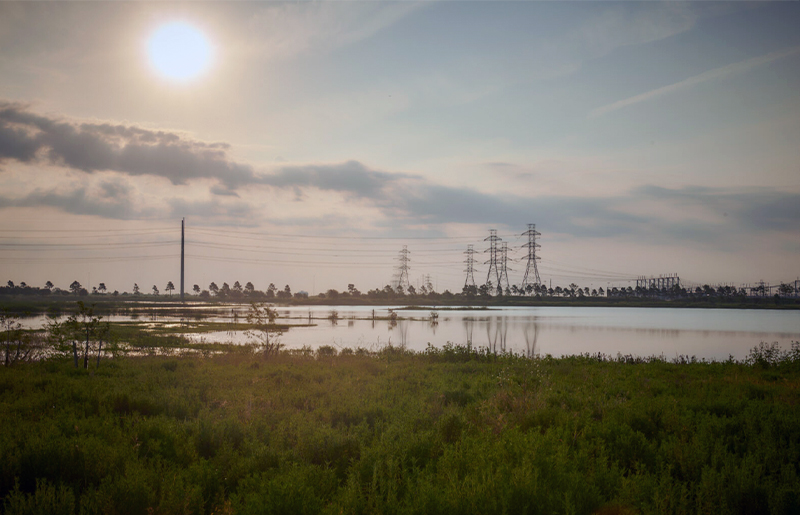
Completed Stormwater Detention Basin at John Paul Landing Park Boosts Flood Resilience and Environmental Restoration in Cypress
Harris County Precinct 4 has officially completed a major stormwater detention basin at John Paul Landing Park, marking a significant milestone in the region’s efforts to improve flood resilience, water quality, and environmental sustainability. This project, part of the Upper Langham Creek Frontier Program, combines infrastructure and ecology to protect the rapidly developing Cypress area from severe flooding while enriching the surrounding habitat.
Addressing Flood Risk in Northwest Harris County
Over the past decade, severe rainfall events have repeatedly exposed vulnerabilities in Harris County’s stormwater systems. In May 2021, flash flooding caused widespread disruption across Northwest Harris County, including Cypress, where overwhelmed drainage systems led to power outages, road closures, and home damage. Earlier, Hurricane Harvey in 2017 dropped over 50 inches of rain in parts of the region, classifying it as a 500-year flood event. These repeated disasters reinforced the need for expanded detention capacity along watersheds like Langham Creek, which runs directly through the John Paul Landing area.
To proactively address growing concerns around stormwater management, the Harris County Flood Control District (HCFCD) and the Harris County Engineering Department (HCED) began conducting detailed drainage studies and digital modeling in the Cypress Creek and Langham Creek watersheds as early as 2006. Aimed at better understanding the region’s hydrology, particularly in the areas surrounding what would become John Paul Landing Park, the studies ultimately identified the need for increased flood detention capacity to support both existing development and anticipated growth in the region.
Project Funding and Completion
In August 2022, Harris County Commissioners Court approved a joint funding agreement that provided $3.18 million from the 2018 Bond Program (Bond ID Z-04) for the stormwater detention project. Now completed, the 865-acre facility, officially known as HCFCD Unit U502-02-00, offers an estimated 2,360 acre-feet of stormwater storage—critical capacity designed to mitigate flood risks in Precinct 4 communities.
Mobile Sidebar Ad
JMT’s Innovative Stormwater Wetland Design
To design a detention solution that would serve more than just flood control purposes, Harris County selected Johnson, Mirmiran & Thompson (JMT) to lead the engineering and ecological design. JMT’s approach emphasized both floodwater detention and environmental enhancement. The newly completed wetland expansion includes a 75-acre basin hydraulically connected to both the existing 176-acre John Paul Lake and Langham Creek. The connection allows water to move freely through the system, improving flood control while mimicking the flow patterns of natural wetlands.
JMT’s multi-phase construction plan added 650 acre-feet of additional detention volume, or roughly the equivalent of 325 Olympic-sized swimming pools. These phases included varying pool depths (3 to 8 feet) to encourage sedimentation and pollutant filtration. Curvilinear shorelines and vegetative shelves near the water's edge enhance water quality while supporting native wetland plants from the Texas Western Gulf Coastal Plains.
Environmental and Ecological Impact
The new basin is more than a flood mitigation feature—it’s a functioning ecosystem. JMT’s design includes habitat islands spaced 50 to 75 feet apart, offering nesting and foraging spaces for shorebirds, amphibians, and other species. The islands, vegetative zones, and shelves are irregularly graded to maximize biodiversity and create micro-habitats for different species.
According to the Harris County Flood Control District, modern detention basins like this one are designed not only to reduce flooding but also to “support habitat restoration, improve water quality, and reduce erosion.” The U.S. Army Corps of Engineers (USACE) further supports the environmental value of such projects, noting that nature-based flood management approaches “enhance natural hydrology and support long-term biodiversity” in urban regions.
To ensure sustainability, JMT incorporated safety and access features such as gradual 3:1 slope gradients, a 30-foot-wide maintenance berm, and ADA-compliant hiking and biking trails. These improvements make the site accessible while protecting both human visitors and local wildlife. The project also included a temporary channel reroute of Langham Creek during phase two, ensuring uninterrupted flow and environmental stability during construction.
Mobile Sidebar Ad
Community Amenities and Education
In addition to flood protection and habitat restoration, the detention basin enhances public engagement and outdoor learning. Located next to the park’s environmental education center, the new Discovery Cove was designed as a 10-acre outdoor classroom that showcases the basin’s habitats. Future plans may include a floating boardwalk, observation tower, and kayak launch, inviting residents to learn more about stormwater systems and local ecology.
John Paul Landing Park, already a vibrant community destination, now features expanded recreational space surrounding the lake, including a cricket field, licensed fishing areas, exercise stations, playground, and reservable picnic pavilions. Hiking and biking trails allow visitors to explore the basin and witness its ecological functions firsthand.
A Model for Resilient Infrastructure
The completion of the stormwater detention basin at John Paul Landing Park reflects a broader strategy in Harris County to develop multi-benefit infrastructure that prioritizes flood risk reduction, public recreation, and ecological resilience. Through the collaborative work of Harris County Precinct 4, HCFCD, JMT, and other partners, this project sets a new standard for how communities can prepare for extreme weather while restoring natural ecosystems.
 Tiffany Krenek has been on the My Neighborhood News team since August 2021. She is passionate about curating and sharing content that enriches the lives of our readers in a personal, meaningful way. A loving mother and wife, Tiffany and her family live in the West Houston/Cypress region.
Tiffany Krenek has been on the My Neighborhood News team since August 2021. She is passionate about curating and sharing content that enriches the lives of our readers in a personal, meaningful way. A loving mother and wife, Tiffany and her family live in the West Houston/Cypress region.





